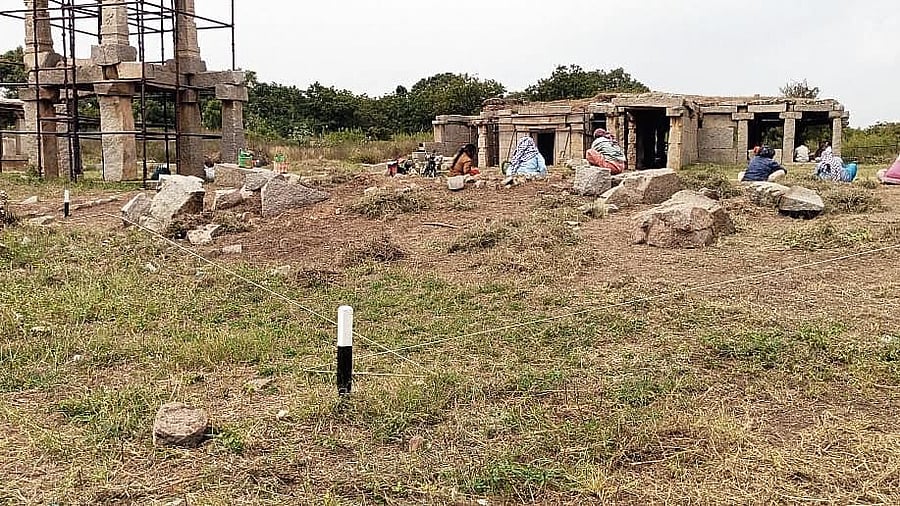
Labourers clear an area near Hazara Rama Temple in Hampi for excavation. The Archaeological Survey of India (ASI) officials believe that the one-km stretch of Pan Supari Bazaar is the area where traders were selling gold, diamonds and other precious metals during the peak of Vijayanagar kingdom.
Credit: Special arrangement
Hubballi: The Archaeological Survey of India (ASI) officials are excavating the one-kilometre-long Pan Supari Bazaar stretch between Hazara Rama Temple and Shrungarada Hebbagilu (Beautiful Main Entrance) at Hampi in Vijayanagar district.
They believe this stretch of road, called ‘Pedda Angadi Veedhi’ (Big Shop Street) during the Vijayanagar period, is where gold and other precious metals were sold during the peak of the massive medieval South Indian kingdom.
In the last 10 days of excavation, they have unearthed potsherds, like redware, greyware and porcelain. A terracotta bead and a coin, made of either bronze or copper, said to be belonging to the 15th century, have also been found.
The excavation is based on the chronicles and epigraphs found in various temples, monuments, and books by travellers.
“Most of the research at Vijayanagar has focused on the city’s southern, western (most extensively worked area) and northern regions. The eastern part of the city is relatively less explored,” Nikhil Das, ASI Hampi Circle superintending archaeologist, said.
“Inscription on temples and records of foreign travellers gives indisputable evidence of a thriving marketplace at a place which is now known as Pan Supari Bazaar,” Das said.
He said the description also points out that ‘Pedda Angadi Veedhi’ is the place where the trade of precious metals was taking place.
Persian traveller Abdul Razzaq, in his chronicles, has written about the presence of four Bazaars by the king’s palace which were ‘extremely long and broad, placed opposite to each other’.
His chronicles also describe that each class of men belonging to each profession had contiguous shops; the jewellers sold publicly in the Bazaars; pearls, rubies, emeralds, and diamonds.
Domingo Paes, a traveller from Portugal, also has given an account of the Bazaar noting the sale of valuable products along with an evening fair.
“The description in their books leads to Pan Supari Bazaar,” Das said.
This is not the first time that excavation has been taken up in this area. In 1985, the ASI started excavating the 150 sqm area in front of the Hazara Rama Temple and found evidence of extensive trading of areca and its allied products.
They, however, did not discover any large structures or monuments then. The excavation had to be stopped due to the paucity of funds.
The Union government has now allocated Rs 7 lakh for the excavation with a promise of allocating more funds.
The officials have dug up three trenches of 10X10 at Enclosure-16 with the hope of finding traces of a thriving market area in the 650 sqm area.
To join hands with students
The ASI wants to speed up the process of excavation and is planning to join hands with the Department of Archaeology at various Universities and colleges.
“This could be a win-win situation for both students and the ASI, as the research students will get a first-hand experience of excavating one of the most important historical sites under the guidance of experts and at the same time, the ASI will get more skilled human resources to excavate the area,” Das said.